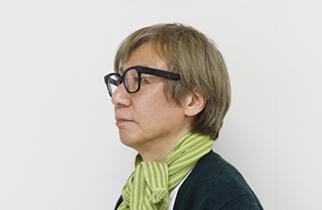
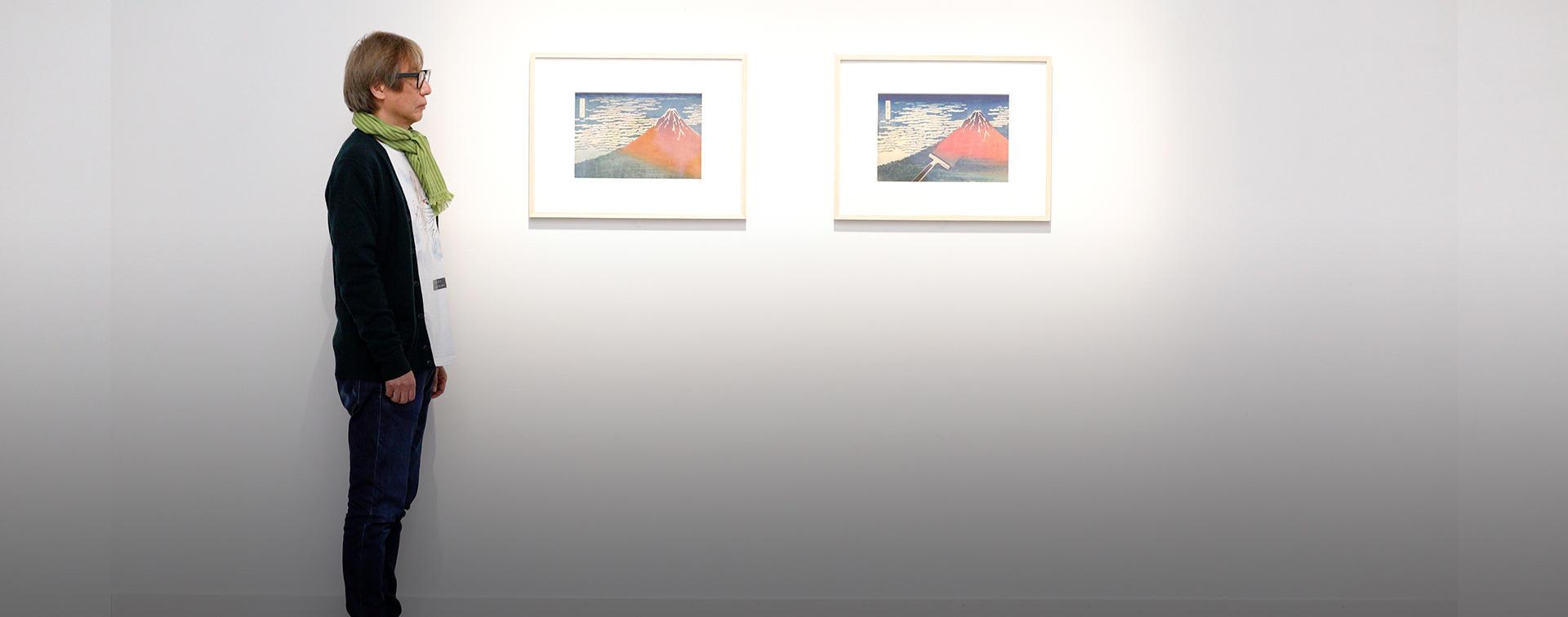

INTERVIEW
115
Shiriagari KotobukiManga Artist
Create the Kind of Chaos that Can't Be Experienced on the Internet with a Massive Party Event
You might make mistakes, screw up, but a "stuff happens" attitude makes everything much more fun.
Shiriagari Kotobuki maintains a laid back, surreal, subcultural mindset in posting daily manga to a broad audience. At the Timeless Conversations 2020: Voices from Japanese Art of the Past and Present exhibition scheduled for the National Art Center, Tokyo , Shiriagari will be presenting Nearly 36 Somewhat Ridiculous Views , a parody series of the all-too-famous Thirty-six Views of Mount Fuji by Edo period artist Katsushika Hokusai. This series is in keeping with his usual art style, with humor that creeps up on you over time, but then slashes with sharp commentary when you least expect it. We asked the artist how this style came to be, unleashing a wide array of topics including what parody and Hokusai mean to him, the relationship between gag comics and art, and the recent state of society.
Hokusai was an entertainer at heart who saw humor in everything
Even as a youngster, I always loved parody. I loved it so much that in the initial days after my debut, all of my manga was drawn in someone else's style, and I said pretentious things like, "If a person's drawing style is different every time but still has a signature look to it, that's real individuality." Age-wise, I was inspired by things like the subculture magazine Bikkuri House and Monty Python. When they told me I could play around with Hokusai in this exbhition, I knew I had to do parody. Because, well...parody only works if people know the source material, you know? And people all over the world know Hokusai's works. It's almost a tossup between his fame and Renoir's. ...Maybe that's going a bit far. (laughs) Anyway, it was my chance to make parody of works that are incredibly well known. What's more, now there's this handy thing called Photoshop, and trying that out was so much fun. I only intended to make ten pieces or so, but then I decided to do all of them, and to my surprise somehow ended up with forty-six pieces instead of thirty-six. I guess Hokusai's work is suited for parody. Each one of his compositions is so distinctive, that it's clear which part you want to take and flip on its head. Looking at his Hokusai Manga sketches are really inspirational too, for their sheer amount of energy.
In terms of classic art, I've always liked fantasy and strange themes over realistic ones. Like yokai (supernatural beings and creatures) in Japanese art. Japanese yokai are kind of endearing in a way and not too scary, right? I think Hokusai was an entertainer at heart, trying to amuse or suprise people. His giant picture of the Great Daruma is a perfect example. Plus, he seemed to see humor in everything. Even when he drew a samurai for example, he didn't take it too seriously, and wasn't worried about drawing him all pompous and arrogant, just the way he saw it. I love that blitheness, or the kind of laid back attitude he had.
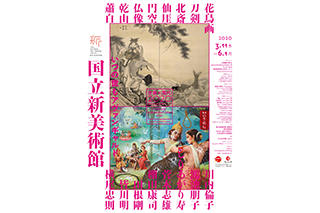
Timeless Conversations 2020: Voices from Japanese Art of the Past and Present
This exhibition unites art from past eras with contemporary art to reexamine the appeal of Japanese art from new perspectives. This includes a look at thematic and structural similarities, as well as inspiration taken from pioneering work, universally recognized masterpieces alongside parody, and installations that incorporate works of classic art. The total number of contemporary and classic works on display come to approximately 200 pieces, showcasing the classic/contemporary combinations of bird-and-flower paintings/KAWAUCHI Rinko, Japanese swords/KONOIKE Tomoko, Hokusai/SHIRIAGARI Kotobuki, Sengai/SUGA Kishio, Enku/TANADA Koji, Buddhist statuary/TANE Tsuyoshi, Kenzan/MINAGAWA Akira, and Shohaku/YOKOO Tadanori. The exhibition is scheduled to be on display until Monday, June 1, 2020 at the National Art Center, Tokyo.
It's cool and interesting because it's just a little change
I included the "somewhat" in my series title Nearly 36 Somewhat Ridiculous Views because I only wanted to change the source material "somewhat." There's no end to what you could do if you made lots of changes to the original, but I think it's much cooler when a single modification changes the entire meaning of the picture, or if you can't even tell what's been changed. Kind of like how in Judo, it's really cool when a hardly noticeable move flips the opponent down on the floor. For example, I really only changed things a bit in The Earth as Seen from the Sun. Simply changing the colors and switching Mount Fuji with the Earth zooms the scene out all of a sudden, from Kanagawa Prefecture all the way to the solar system.
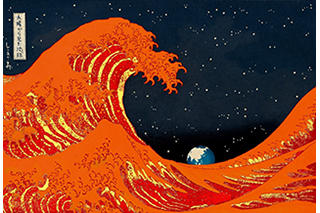
The Earth as Seen from the Sun
A parody of The Great Wave off Kanagawa, one of the most famous of Hokusai's Thirty-six Views of Mount Fuji.
SHIRIAGARI Kotobuki
The Earth as Seen from the Sun from the series Nearly 36 Somewhat Ridiculous Views 2017, Collection of the artist
On show: May 8 - June 1
I also made an animated installation entitled Katsushika Hokusai: Creating the Universe from a Four-and-a-half-mat Room. To the very end, Hokusai drew in a space that was the size of four-and-a-half tatami mats. That's a really tiny space. But the things he drew there were unbelievably expansive and huge, expressing the entire universe. That's what makes Hokusai so amazing, and I think it's a great example of what it's like to make art. All you need is four-and-a-half tatami mats worth of space and a brush, and it's possible to create endlessly enormous things. I don't think Hokusai was a food connoisseur and I'm sure he wasn't big on fashion either. He even moved houses all the time to avoid having to keep things tidy. He seemed to enjoy traveling, but he would be drawing the entire time. To think he was able to do what he did as long as he was given a brush and paper makes me feel like our lives are too luxurious, that we need to learn from him. So I wanted the animation to show the enormity of what Hokusai created from that minimum four-and-a-half-mat space. Was this one a little too obvious, for my work? (laughs)
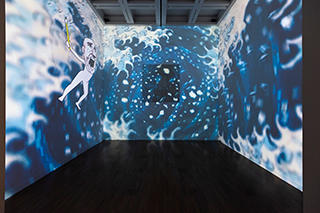
Katsushika Hokusai: Creating the Universe from a Four-and-a-half-mat Room
An animated work directed by Kotobuki Shiriagari to be aired in the exhibition. It contrasts the tiny four-and-a-half-mat space with the worlds that Hokusai created, such as by showing Hokusai with brush in hand leap nimbly out of the room and dance around. Shiriagari's favorite is the final scene. Come check out what happens in person.

Where gag comics and art overlap
Gag comics come in all kinds of flavors. Art encompasses an even wider set of things, but I feel like something about gag comics and art overlap a bit. Like the way they both overturn common sense and present the world with things that cannot be captured through conventional ways of thinking. I like how they kind of overlap there for a moment. Some gag comics are heartfelt and cheer people up or make them feel better, but I put weight on making people think, "Really? Is he allowed to do that?" or "I didn't expect that there." In the same way, some art is grand and made to be put up in a palace somewhere, but some subvert expectations and make people think, "Huh? What is this?" The latter is how I want my work to overlap.
In any case, the most important thing is that there's not just one right answer. This exhibition has all kinds of pairings between contemporary and classic art, but these aren't necessarily the "correct" answers, are they? They're just a few out of a multitude of possible combinations, and there's potential for so many more interesting pairings between artists and classic works of art. That's why I think Japanese art doesn't have a simple answer, either, and it's interesting to imagine all kinds of connections and similarities.
If I were to be a body part, I would want to be an eye
If I had to be some part of the human body, I wouldn't be a foot or a hand or the head because I'm not active and I'm a coward. Thinking about it like that, I think it only makes sense that I'd be an eye. I just want to look at the world and draw the things I see. And as long as I'm doing that, I don't want to look at what everybody else is seeing. I want to look at things a little differently, like from the backside or at an angle, you know? If I don't, then I wouldn't be fulfilling my role as an eye. I think that's why my style of art came to be the way it is. If I had a different personality, maybe I would have been super vocal in putting out messages, or the type who analyzes society using my brain, or maybe even used my arms and legs to be a lot more active.
I have a newspaper comic strip called People of the Earth Defense Family, and if I were to point out one thing I keep in mind when drawing it, it's to keep the stuff I don't understand ambiguous. Delivering something through mass media means that I need to be careful not to lie. So I can't come out and say things unless I'm convinced that they're not wrong. That's why my comic strips are full of things I don't understand, and so vague that it's kind of a problem (laughs). I tell myself, "Come on, you need to be sharper in your commentary!" And that leaves me wanting, to tell you the truth. Sometimes I envy the types of people who are good about saying things straight up, but everyone has their strengths and weaknesses. Some people are good at understanding things, and some are good at putting out stuff that they don't understand themselves. I figure society has a balance of those two kinds of people, so I guess my job is just to do what I can do. Though I do think I'm too okay with the things I don't understand.
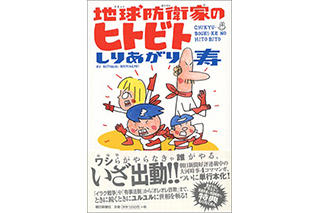
People of the Earth Defense Family
A four-panel comic strip that has been serialized in the evening edition of The Asahi Shimbun newspaper since April 2002. The "Earth Defense Family," a family of four who claim to be defenders of the planet make sometimes fluffy, sometimes biting social commentary.
Asahi Shimbun Publications
Newspaper strips are pretty difficult to do. There's a huge readership, and people don't read the newspaper looking for a laugh. It's not a place for challenging readers with complex humor to see if they "get it." Besides, I can't hope to compete with the young artists drawing for comic magazines these days in that regard. My gag comics are disposable--humor that might be funny one day but not anymore the next day. It's a different style from humor that builds up to make people laugh, like rakugo (traditional Japanese storytelling humor). Disposable humor chips away at material you're born with, so obviously young people have a lot more in stock. I only have a tiny bit left in me (laughs). Maybe I should have tried harder to hone my skills in humor, too, like rakugo performers.
Beauty born from "life or death"
I drew Manga Ever Since after the 2011 disasters, but I thought that matters in Japan had been getting progressively worse in all kinds of ways, even before "3.11." So I thought that 3.11 would be the finishing blow for the country, but Japan somehow managed to keep pressing on. But with the coronavirus, I think this is really it. With 3.11, it was like the ground had been pulled away from under our feet, and there was the shock from suddenly being torn away from life as we knew it. But this time, it's less of a sudden loss, like sand slowly crumbling away from under us, which is incredibly bad in its own way. I'm sure Japan will still fight on, but the economic damage from this is going to be horrible.

Manga Ever Since
A compilation of manga, including a work published in a magazine just one month after the 2011 Tohoku earthquake and tsunami, as well as strips that captured the day-to-day changes in the aftermath of the disaster and how society stumbled through it, such as from People of the Earth Defense Family serialized in the Asahi Shimbun newspaper.
Released July 2011 through urgent publication, drawing much attention.
© Kotobuki Shiriagari/KADOKAWA
Well, maybe we can learn from Hokusai in that regard, which I know is a weird thing to say, but just around the time after Hokusai passed away, Japan had a cholera outbreak. There must have been plenty of infectious diseases back then, so I imagine life or death situations were much more common and immediate. But Hokusai didn't let that fluster him and managed to create a countless number of drawings. So yeah, I think if people in the past could do it, we should be able to as well.
In this exhibition for example, Tomoko Konoike's work entitled Drop Curtain of Cowhide displays Japanese swords with animal hide hanging down. When you think about it, swords are tools for killing people. When you pair that with skin stripped off of some animal, you end up with a kind of beauty that comes from the concept of life or death. Seeing that kind of work makes me think I need to feel life and death with more immediacy. We tend to think about them as things that happen in some world far away from our own, but we should realize they're much more immediate, and draw the things that we still feel the need to draw regardless. Huh... The topic's getting a bit too serious for my style (laughs).
People are free to come up with ideas, but we need competition and selection
I think that up until now, Japan believed in a kind of fantasy that there's an ideal answer waiting for us in the future, although we have no idea what that might be, and that despite these twists and turns, we will get there as a matter of course if we work diligently enough, as if riding on an escalator. But seeing the emergence of a certain wacky president and more countries around the world looking like dictatorships when they're supposed to be democracies, it's clear that things aren't that easy. So all we can do is look to our individual selves. Instead of waiting for somebody somewhere to give us the answer, we need to try moving in the direction of what we really want to do, or what we think is good. I'm sure there'll be a lot of friction during that process. But we're at a point where only being pleasant won't work anymore, and I feel like we need that friction, to start fighting things out. I don't have that much time left so I'm going to keep things friendly (laughs). But young people need to create friction, fight things out, resist, and persevere.
They talk about freedom of expression, and it's true that people are free to come up with ideas. But those ideas aren't all going to be chosen. They go through a culling process, but I think the current culling process isn't severe enough. Anyone is allowed to come up with ideas and people should definitely be free to speak their minds, but I'm just worried that there's no rigorous competition or culling process going on anywhere to make sure that only the best ideas survive. Of course, that's not to say that rigorous is necessarily good, but I have to wonder if appropriate competition and selection is going on. Do you ever wonder that? Like when you see something selected in a competition that makes you go "Why did they choose that?!" and you just assume that there was some kind of ulterior motive behind the decision. I see it everywhere, like in elections and entrance exams and job-hunting, where things aren't selected properly and the results seem fixed. I want people to be able to tough it through fights and win their own paths in life with their own hands.
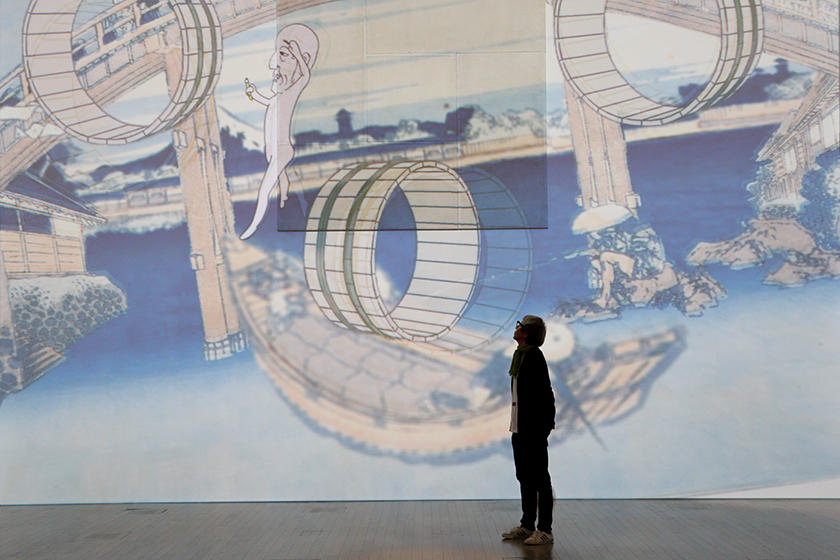
Only say you want the things you really want
If I had to choose my favorite cities in the world, my first choice is definitely Tokyo. Though I love Tainan, too, because there are lots of delicious things there. I love the city of Tainan, or more specifically the food stalls (laughs). I haven't traveled around Africa too much, but it's fascinating how it feels like people are springing up out of the earth there. Where does that vitality come from? Maybe it's not good for people to cover land in asphalt. Going to places like that makes me think maybe people actually get nutrients straight from the land, too.
I like Tokyo because I know a lot of people here, there are lots of delicious things to eat, and it's safe. I like Roppongi, too. Back when I used to work for a company, my work involved Heartland Beer. The Mohri estate garden, though it's gotten a lot smaller now, is located around the TV Asahi area, and we used to run a beer hall there. Little establishments tucked away in that district popped up and disappeared all the time. It was like that all over Roppongi back then, and I find that kind of culture fascinating. Plus you could wander around the town drunk, choosing one establishment one day and a different one the next. These days, Roppongi has gotten so grand that I rarely come here anymore. I have an inferiority complex, so I get intimidating by grand things and feel alienated. I feel at home in more unimportant places, but I'll try my best and come here more often (laughs).
When I was a businessman I made commercials and stuff, but commercials have to make people want things that they don't necessarily want, right? You might even say that commercials are supposed to make people want things that they don't really want, to the extent that they think they can't be happy without them. That's the kind of sinful work I used to do, but I think people should speak up more and say they don't want the things they don't want, and say they only want the things that they really want. Though I realize that's easy for me to say.
The difficulty of "making people laugh" and the comfort of "being laughed at"
If I could do something with an unlimited budget and scale, I'd want to create a drinking establishment. When we did the Heartland beer hall, we had talked about wanting to make it like a version of Disneyland where you could drink beer. With the power of alcohol, I want to create a place where the line between dream and reality is ambiguous. Every year, I hold a 300- to 400-person event called "Sarufes" in Shinjuku Loft , and what I have in mind is something like that, only a lot bigger. I'd rent out an entire building, and once you opened the door there'd be surprises inside that no one would ever expect, stuff you'd never be able to experience on the internet. Actually, I did do something similar before in Tokyo Midtown . It was a kind of general meeting for the Japan Inter-design Forum , and they told me, "Shiriagari-san, you can do what you want with the event." So I planned to have people reading out comics in one area and playing death metal in another, but it wasn't realistic because we only had one floor of space. I mean, you can see what's going on in the other area, and the noise is distracting (laughs). But I think that kind of thing would definitely be possible as long as there was enough money. I hope you'll let me do it in Roppongi when that happens .
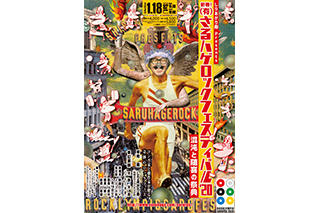
Sarufes
A New Year's event hosted by Shiriagari's company, Saruyama Hagenosuke Co., Ltd. Officially called "Kotobuki Shiriagari Presents: The New Year Saruhage Rock Festival." A diverse collection of artists perform simultaneously on multiple stages in this festival for grownups, which starts in the evening and runs deep into the night.
Artwork by Tengai Amano, Shiriagari Kotobuki
Though both humorous, "being laughed at" and "making people laugh" are two different things. "Making people laugh" requires a lot more than it looks, because people put their guard up the moment they realize that someone is trying to make them laugh. To get past that guard and actually make them laugh requires more than a little skill, and going for a laugh and failing is really demoralizing. Timing and other aspects of humor are very delicate, so sometimes it's better not to try too hard to make it happen. That's why rakugo performers and comedians who can overcome all that and make people laugh are truly amazing! Personally, I find it easier to be laughed at, and I've made my living through my ineptitudes, my mistakes, and the general image that I'm "screwing up." Although that can sometimes lead straight to bullying and ridicule, so it's not easy.
Meanwhile, humor also depends on the audience, because one person might find something funny and say, "That's so silly," while a different person might find it disgraceful. And when people think something's disgraceful, they move to shut it down for being "bad." But when you put humor in a box like that, you get less humor overall. An audience has to be accommodating to see humor in things. If only someone would write an essay about how "disgraceful humor is beneficial to society," or something like that.
Editor's thoughts
I conducted the interview just as the start of the exhibition was being postponed due to the novel coronavirus. Shiriagari-san's gentle way of talking left an impression on me, whether he was talking about the parodies he loves so much, or talking about the uncertainty of the immediate future. The way he played dumb when the topic took a serious turn, laughing that it wasn't his style, echoed his comic (or performance?) style. While he modestly said that he's "too okay" with the things he doesn't understand, he actually excels at showing his wide perspective on things, then slipping sharp commentary into his laid back style. Please continue to act as society's "eye," and delight us with perspectives that are "somewhat ridiculous." (text_ikuko hyodo)
RANKING
ALL
CATEGORY




